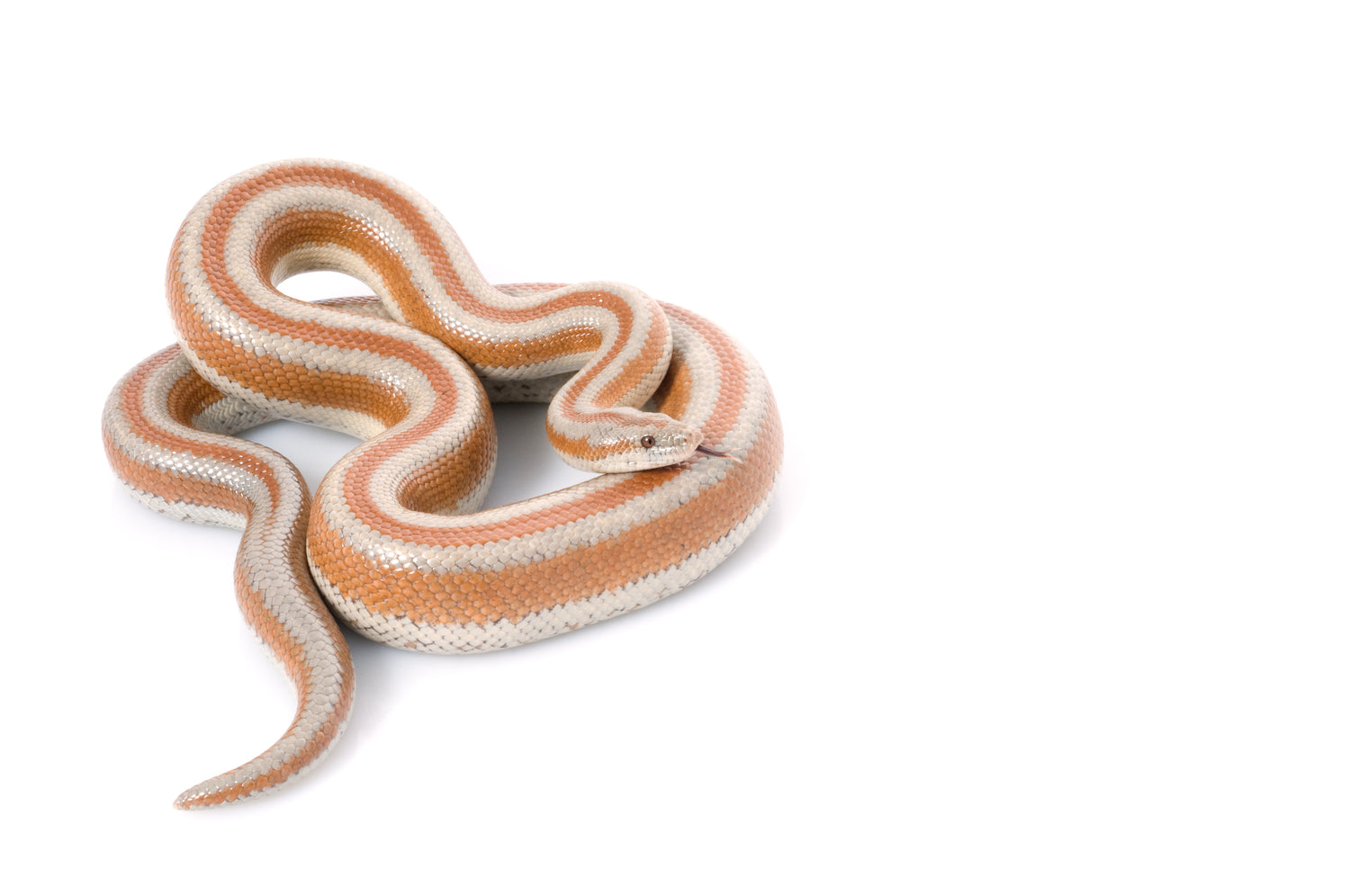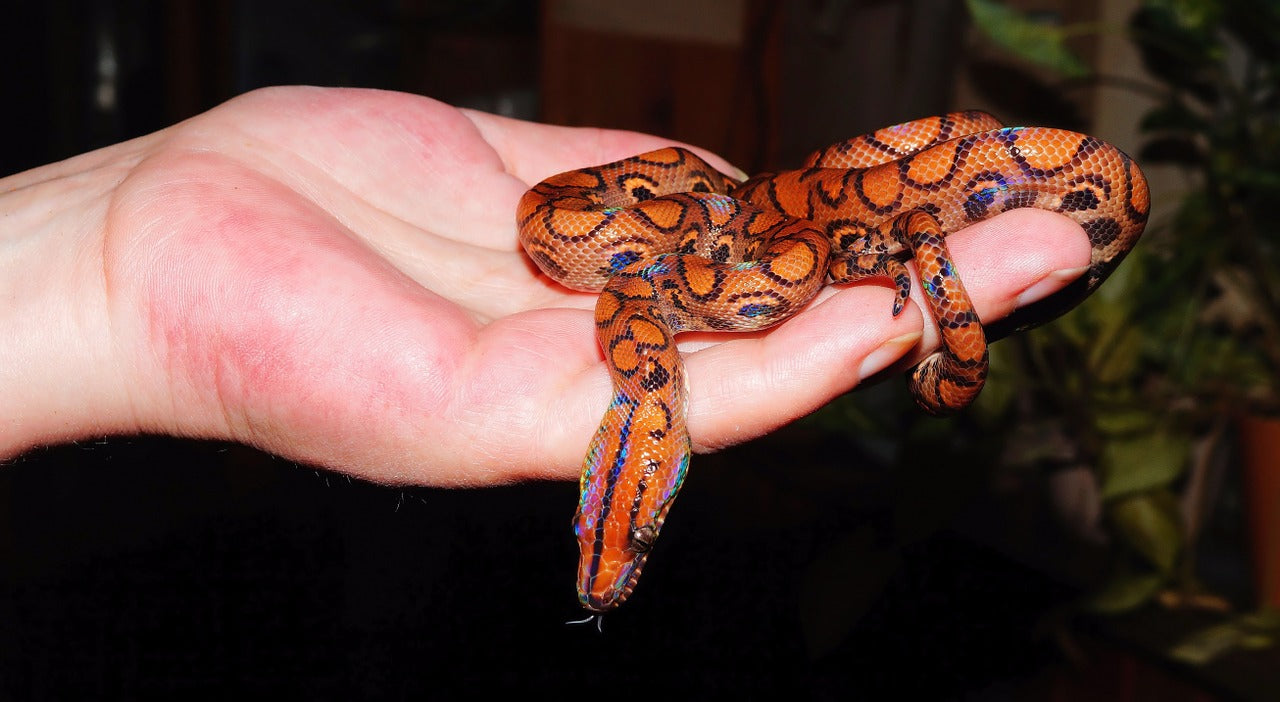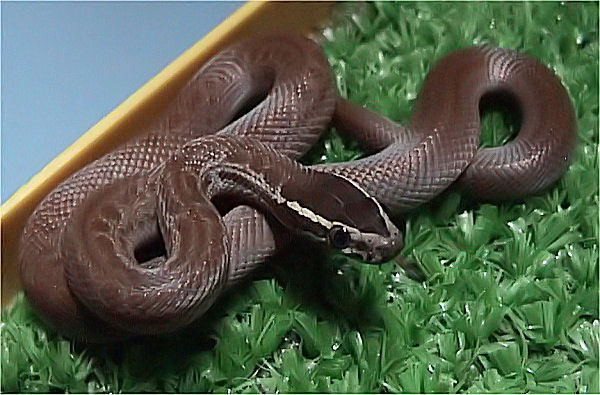Rosy boas (Lichanura trivirgata) are small, terrestrial snakes native to the southwestern United States and northern Mexico. Their preferred habitat is semi-arid to arid areas such as rocky mountain slopes and dry shrublands.
Rosy boas can grow anywhere between 1.5-4’ long, depending on subspecies and locality. Females are generally longer than males. They have a robust body, small oval head, and smooth scales. Color and pattern varies widely by locality. The pattern generally consists of broad stripes running the length of the snake’s body, although some are better defined than others. These stripes can be orange, red, brown, or black. Base color can be white, cream, tan, yellow, or gray.
Due to their small size, general hardiness, and docile temperament, rosy boas are beginner-level pet reptiles. With good care, they can live 25+ years.
How much space do rosy boas need?
A good starting point for any rosy boa is a 36”L x 18”W x 18”H enclosure. Larger is better, of course!
Cohabitation (keeping multiple rosy boas in one enclosure) is not recommended, as like most snakes, rosy boas are not a social species, and keeping them together is likely to cause more stress than benefit.
Do rosy boas need UVB?
They can survive without it, but it’s still best practice to provide UVB lighting for optimal health and wellbeing. UVB gives snakes all of the vitamin D that their bodies need, stimulates better appetite and activity, and generally allows them to be healthier than they would be without.
Here are the best UVB bulbs for rosy boas:
- Zoo Med T8 Reptisun 5.0
- Arcadia ShadeDweller
The UVB bulb should be housed in a reflective fixture and placed on the same side as the heat lamp. Place the basking surface 8-13” below the bulb. UVB is blocked by glass and plastic, so you can’t give your snake UVB by placing its terrarium in front of an open window. Also make sure that the fixture your UVB bulb is in does not have a clear plastic bulb cover.
Lights should be on for 14 hours/day during summer and 10 hours/day during winter. This replicates seasonal light cycles, encouraging healthier hormonal rhythms and possibly better long-term health.
What basking temperatures do rosy boas need?
Like other reptiles, rosy boas are ectotherms, which means that they need a temperature gradient in their enclosure to help them regulate their metabolism and stay healthy.
Rosy boas should have a basking surface temperature of 90°F directly under a heat lamp placed to the extreme right or left of the enclosure. On the other side of the enclosure, the temperature should be between 70-75°F. Measure temperatures with a digital probe thermometer placed on each side.
Provide heat for your rosy boa by imitating the sun with a halogen heat lamp placed on one side of the enclosure, positioned over the warm hide. Do not use ceramic heat emitters (CHEs), heat mats, red bulbs, or blue bulbs, as these are not as effective.
Heating should be turned off at night.
What humidity levels do rosy boas need?
Rosy boas prefer environments with low to moderate humidity and good ventilation. Average air humidity in your rosy boa’s enclosure should always be below 60%, as measured by a digital probe hygrometer placed in the middle of the enclosure.
Although the enclosure can be kept fairly dry, it’s a good idea to offer a humid hide lined with moistened substrate for the snake to use as desired. This is especially helpful during shedding.
What substrate is good for rosy boas?
Substrate (also known as bedding) cushions your snake’s body, stabilizes humidity, also helps make the enclosure look more attractive! We recommend the following substrates for rosy boas:
Substrate should be at least 3” deep and completely replaced every 3-4 months. Remove poop and urates daily, along with contaminated substrate.
What décor can you use in a rosy boa terrarium?
It’s terribly boring for a snake to be stuck in an enclosure with nothing in it except substrate and a water bowl. It doesn’t matter how big the enclosure is if you don’t put things in it for your pet to use and interact with.
Here are some décor ideas to help entertain your rosy boa:
- flat rocks/paver stones
- hides/caves
- sturdy branches
- cork flats/tubes
- live or artificial plants
To help your rosy boa feel secure in its environment, make sure to provide plenty of places to hide.
What do rosy boas eat?
Like other snakes, rosy boas are carnivores, which means that they need to eat whole animal prey in order to get the nutrition that they need. Here is a basic feeding schedule:
- Babies and juveniles — every 5-7 days
- Adults — every 10-14 days
Prey items should be the same width as the snake’s widest point or slightly larger. Although live prey can be used, it’s safest and most humane to use frozen instead. Prey should be thawed in a plastic bag in warm water to approximately 100°F before offering with a pair of soft-tipped tweezers.
Remember, the key to great nutrition is variety! Aside from offering mice, young rats and button quail can also be used to create nutritional variety in your rosy boa’s diet.
Supplements
Rosy boas can survive without vitamin or mineral supplements, but occasionally using them can help prevent nutritional deficiencies and optimize your snake’s health. We recommend Repashy Calcium Plus LoD.
Water
Your rosy boa should have access to clean, fresh water at all times. Provide a heavy water bowl large enough for the snake to soak its entire body if desired. Change the water daily and scrub the bowl with a reptile-safe disinfectant weekly, or whenever it becomes soiled.
Do rosy boas like to be handled?
Few reptiles actually “like” to be held, but rosy boas generally tolerate handling well. Be gentle, and pick up the snake from below rather than from above. Support as much of its body as possible, and NEVER pick up a snake by its tail! Biting is uncommon for this species.
*This care sheet contains only very basic information. Although it’s a good introduction, please do further research with high-quality sources to obtain additional information on caring for this species.




Leave a comment
This site is protected by hCaptcha and the hCaptcha Privacy Policy and Terms of Service apply.